
Hymenopappus is a genus of flowering plants in the daisy family. Many species are known as woollywhites.
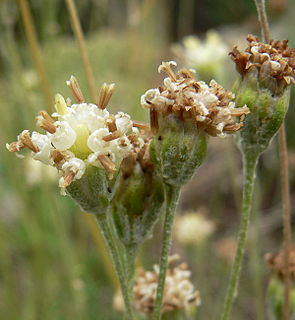
Hymenopappus filifolius is a North American species of flowering plant in the daisy family known by the common names fineleaf hymenopappus and Columbia cutleaf. It is native to western and central North America from Alberta and Saskatchewan south as far as Chihuahua and Baja California.
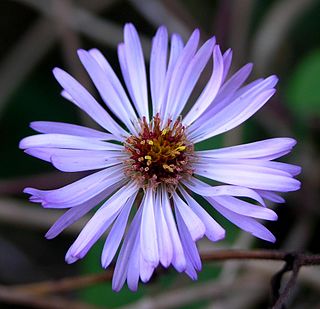
Ampelaster is a North American genus of flowering plants in the family Asteraceae.
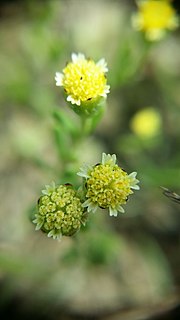
Hymenoxys texana is a rare species of flowering plant in the aster family known by the common names prairie dawn, Texas prairie dawn-flower, and Texas bitterweed. It is endemic to Texas, where it is known only from the general vicinity of Houston. It is threatened by the loss of its habitat. It is a federally listed endangered species of the United States.

Encelia nutans, called noddinghead, or nodding sunray, is a North American species of flowering plants in the family daisy family. It has been found only in Utah and Colorado in the western United States.
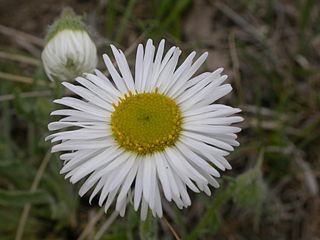
Erigeron ochroleucus is a North American species of flowering plant in the family Asteraceae, called the buff fleabane or buff daisy. It is native to western Canada and the western United States from Alaska and Yukon southeast as far as Colorado and Nebraska.
Grindelia arizonica, the Arizona gumweed, is a North American species of flowering plants in the family Asteraceae. It is native to the southwestern United States and northern Mexico, in the States of Coahuila, Chihuahua, Arizona, New Mexico, Utah, Texas, and Colorado.
Hazardia whitneyi, common name Whitney's bristleweed, is a North American species of shrub in the daisy family. It has been found only in the states of Oregon and California in the western United States.

Hedypnois rhagadioloides, the Cretanweed or scaly hawkbit, is a species of plant in the tribe Cichorieae within the family Asteraceae. It is native to the Mediterranean Region and neighboring areas from Canary Islands to Iran, and naturalized in Australia and in parts of the Americas.

Hieracium longipilum, the hairy hawkweed, is a North American plant species in the tribe Cichorieae within the family Asteraceae. It is widespread across much of central Canada and the central United States from Ontario south to Texas and Louisiana. There are old reports of the species growing in Québec, but apparently does not grow there now.
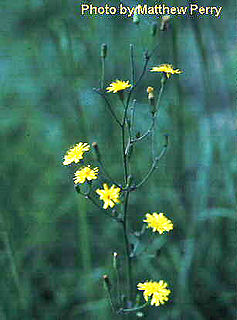
Hieracium paniculatum, the Allegheny hawkweed, is a North American plant species in the tribe Cichorieae within the family Asteraceae. It grows only in the eastern United States and eastern Canada, from Nova Scotia west to Ontario, Michigan, and Indiana south as far as Georgia.

Hymenopappus artemisiifolius, the oldplainsman, is a North American species of flowering plant in the daisy family. It has been found only in the south-central United States, in Texas, Arkansas, and Louisiana. Its natural habitat is in sandy soils of prairies and open woodlands.
Hymenopappus biennis, the biennial woollywhite, is a North American species of flowering plant in the daisy family. It has been found in New Mexico and western Texas.
Hymenopappus carrizoanus, the Carrizo Sands woollywhite, is a North American species of flowering plant in the daisy family. It has been found only in Texas, on the Carrizo Sands of the central part of the state.
Hymenopappus flavescens, the collegeflower, is a North American species of flowering plant in the daisy family.

Hymenopappus mexicanus, the Mexican woollywhite, is a North American species of flowering plant in the daisy family. It grows in northern Mexico and the southwestern United States.
Hymenopappus newberryi, or Newberry's hymenopappus, is a North American species of flowering plant in the daisy family. It grows in the states of New Mexico and Colorado in the southwestern United States.

Hymenopappus scabiosaeus, the Carolina woollywhite, is a North American species of flowering plant in the daisy family. It grows in the central and southeastern United States, primarily on the Great Plains an on the Coastal Plain of the Southeast. There are also isolated populations in Illinois and Indiana as well as in the state of Coahuila in northern Mexico.
Hymenopappus tenuifolius, the Chalk Hill hymenopappus, is a North American species of flowering plant in the daisy family. It grows in the central and southeastern United States, primarily on the Great Plains from Texas and New Mexico north as far as South Dakota.
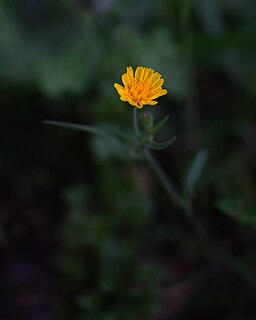
Krigia cespitosa, known as common dwarf-dandelion, opposite-leaved dwarf-dandelion, or weedy dwarfdandelion, is a North American species of plant in the family Asteraceae. It is native to northeastern Mexico and to the southeastern and south-central United States, from Florida to Texas and north as far as southeastern Nebraska, southern Illinois, and central West Virginia












